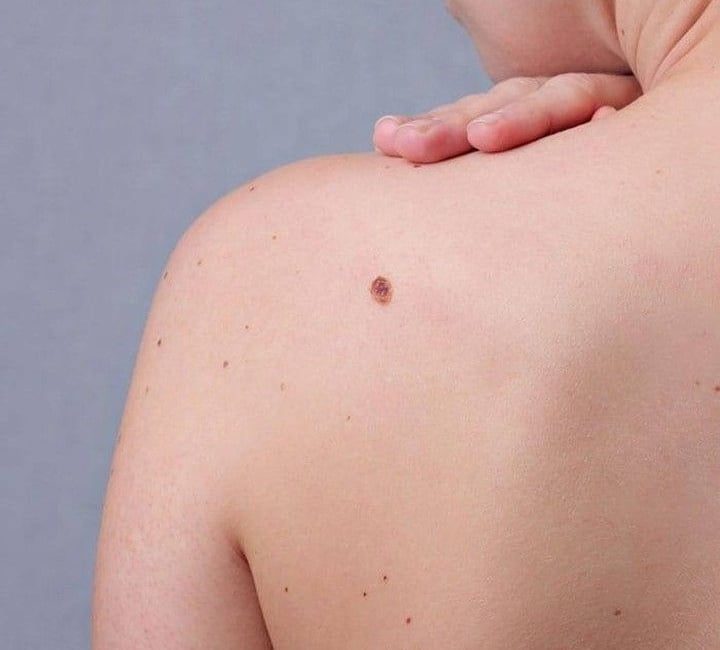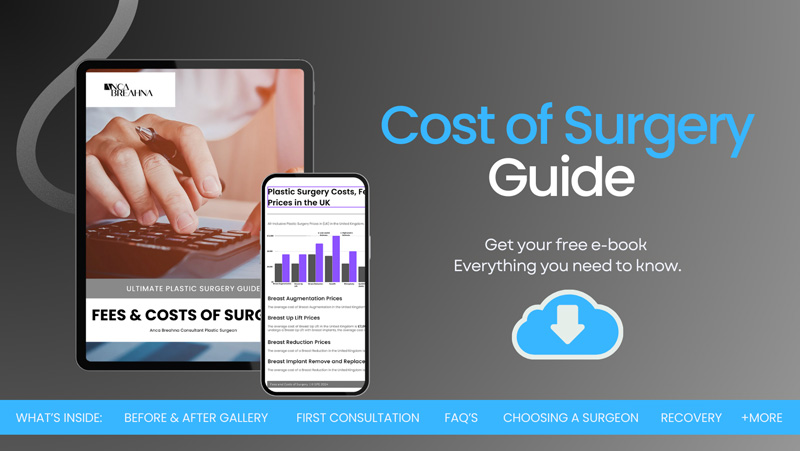Procedures
Wart Removal

Wart removal is a common procedure sought by people dealing with the discomfort and embarrassment of having warts. The decision to remove a wart is often motivated by a desire to improve the appearance of one’s skin, alleviate pain, or prevent the spread of the virus to other parts of the body.
Understanding the nature of warts, the reasons behind their removal, and the options available is the first step towards addressing this skin condition. Whether you’re exploring wart removal for the first time or seeking additional information after trying other methods, this guide by Chester Consultant Plastic Surgeon Anca Breahna is designed to offer a complete overview of the process, helping you make informed decisions about your skin health.
At a glance
Depends on the type of procedure perfomed
Local anaesthesia
A few days
Depends
Usually long-lasting
Table of Contents
What is Wart Removal?
Wart removal is the process of eliminating warts, which are growths on the skin caused by the human papillomavirus (HPV). The process of removing them can involve several different medical techniques, chosen based on the wart’s characteristics and your personal and health considerations.
In most cases, warts can resolve on their own without treatment. However, this process can take months or even years, and there’s always a chance of the warts spreading or becoming more problematic during this time. This is why many opt for professional removal. The procedure not only aims to remove the wart but also seeks to minimise the risk of recurrence, providing a more permanent solution than over-the-counter treatments.
Anca will evaluate the wart to recommend the most effective removal method. This evaluation considers the wart’s size, type, and location, as well as your medical history and any previous treatments. The chosen method aims to effectively remove the wart with minimal risk of scarring or recurrence, ensuring the best possible outcome for you.
Who Needs Wart Removal?
Not everyone who has a wart needs professional removal. For some, warts may be a minor nuisance that can be ignored or treated with over-the-counter remedies. However, there are specific circumstances where professional wart removal becomes a more pressing consideration.
You may be a prime candidate for wart removal if you have warts that are:
- Painful: Warts on parts of your body that receive pressure, such as the soles of your feet (plantar warts), can be particularly uncomfortable, making daily activities challenging.
- Multiplying or spreading: If your warts are spreading to other parts of your body, professional removal can help control the spread.
- Causing emotional or psychological distress: Warts on visible areas like the face and hands can affect your feelings about your appearance, prompting a desire for removal.
- Resistant to home treatments: Warts that do not respond to over-the-counter treatments may require more advanced medical interventions.
Benefits of the Wart Removal Procedure
Undergoing a wart removal procedure comes with several potential benefits, affecting both your physical comfort and psychological well-being. Here are the primary advantages you might experience:
- Improvement in Appearance: One of the most immediate benefits of wart removal is the enhancement of your skin’s appearance. Warts, especially those on highly visible areas such as the face, hands, and feet, can be a source of self-consciousness. Their removal can restore the natural appearance of your skin, potentially boosting your comfort and confidence in social and professional settings.
- Reduction in Discomfort and Pain: Warts located in areas subject to pressure or friction, like plantar warts on the soles of the feet, can cause significant discomfort. Removal of these warts can relieve pain, making daily activities such as walking more comfortable.
- Prevention of Spread: Warts can spread to other parts of your body through direct contact. By removing warts, you reduce the risk of further spread.
- Avoidance of Complications: In some cases, warts can lead to complications, such as infection or changes in skin colouration. Professional removal minimises these risks, especially compared to home remedies or neglect.
- Psychological Benefits: The presence of warts can affect how you feel about your appearance, potentially leading to anxiety or embarrassment. Removal can alleviate these feelings, helping you feel more at ease in your skin.
It’s important to note that while wart removal has many potential benefits, the outcomes can vary based on the individual, the type of warts, and the removal method used. Anca can provide guidance on what to expect from the procedure, tailored to your specific situation.
Types of Wart Removal Procedures
Cryotherapy
Cryotherapy involves freezing the wart with liquid nitrogen, causing it to blister and eventually fall off. This method is particularly effective for warts on the hands and feet but may require multiple sessions to achieve complete removal. The process is relatively quick and can be performed in Anca’s office. While cryotherapy is generally well-tolerated, some patients may experience discomfort or pain during the procedure, and a blister may form at the treatment site.
Electrosurgery and Curettage
Electrosurgery uses an electrical current to burn the wart, while curettage involves scraping the wart off with a sharp instrument. These methods are often used together, especially for larger or more persistent warts. This combination can be highly effective but may leave a scar, making it less suitable for warts on highly visible areas of the body.
Laser Treatment
Laser treatment uses a high-intensity laser beam to destroy the wart tissue. It’s a good option for warts that are difficult to treat with other methods, such as those that are particularly large or located in hard-to-reach areas. While effective, laser treatment can be more expensive and may require a longer healing time, with the potential for pain and scarring.
Chemical Peels
Chemical peels involve applying a strong acid to the wart, which gradually removes its layers. This method can be effective for flat warts, especially on the face, and requires multiple treatments. Chemical peels are less invasive than some other procedures but may take longer to see results.
Topical Treatments
Prescription creams or ointments that stimulate the immune system to fight the HPV virus can also be used for wart removal. These treatments are applied directly to the wart, often over several weeks or months. Topical treatments are less aggressive than procedures like cryotherapy or surgery and are a good option for those looking for a non-invasive approach.
How is the Wart Removal Procedure Performed?
The specific steps involved in a wart removal procedure vary depending on the chosen method, but most follow a general process aimed at minimising discomfort and maximising efficacy. Here’s a breakdown of what you can expect, regardless of the technique:
Preparation
The area around the wart is thoroughly cleaned to prevent infection. Depending on the location of the wart and the removal method, a local anaesthetic may be applied to numb the area and minimise pain during the procedure. This step ensures that you remain as comfortable as possible throughout the process.
Removal
This steps depends on the procedure chosen. Cryotherapy is performed applying liquid nitrogen to the wart using a spray or a cotton swab. For electrosurgery, an electrical current is used to burn the wart tissue. Following electrosurgery, curettage may be performed, which involves scraping away the wart with a sharp instrument. For laser therapy, a laser directs an intense beam of light at the wart, destroying the tissue. Laser treatment can be precise but may result in discomfort, a longer recovery time, and a higher cost. For chemical peels: a strong acid is applied to the wart, causing the layers to peel away over time. This method requires multiple applications and is less invasive, though it may take longer to achieve complete removal. When it comes to topical treatments, prescription medications are applied directly to the wart, often over weeks or months. This non-invasive approach encourages the body’s immune system to attack the wart virus.
Aftercare
After the procedure, you’ll receive instructions on how to care for the area to promote healing, prevent infection, and reduce the risk of recurrence. This may include keeping the area clean and dry, applying prescribed ointments, and avoiding certain activities that could disrupt the healing process.
When it comes to eliminating warts, there are several methods at your disposal, each with its own set of benefits and considerations. Choosing the right wart removal procedure depends on several factors, including the type, size, and location of the wart, as well as your overall health and personal preferences. A consultation with Anca can help determine the most effective and appropriate method for your situation.
Each of these procedures has its own set of advantages and potential drawbacks. By considering your specific needs and consulting with Anca, you can select a wart removal method that offers the best balance of effectiveness, safety, and convenience for you.
Recovery after Wart Removal Procedure
The recovery period following a wart removal procedure can vary significantly depending on the method used and your body’s own healing capabilities. Here’s what you need to know about the recovery process for some of the most common wart removal methods:
General Recovery Tips
- Follow Aftercare Instructions: Adhering strictly to the aftercare guidelines provided by Anca is essential. These instructions may include how to clean the treated area, when to apply or change dressings, and how to use any prescribed medications.
- Monitor for Signs of Infection: Keep an eye on the site of the removal for signs of infection, such as increased redness, swelling, warmth, or discharge. If you notice any of these signs, or if you experience a fever, contact Anca.
- Manage Pain: Some discomfort or pain is normal following wart removal, especially with methods like cryotherapy, electrosurgery, and laser treatment. Over-the-counter pain relievers can help, but it’s important to use them as directed by Anca.
- Allow Time for Healing: Give your body the time it needs to heal. This means avoiding activities that could irritate the treatment area until it has fully recovered. The time required can range from a few days for less invasive treatments like cryotherapy to several weeks for procedures like laser treatment.
Specific Recovery Considerations
- Cryotherapy: Recovery typically involves minimal downtime, though the treated area may blister and be sore for a few days. The blister may take a week or more to heal completely.
- Electrosurgery and Curettage: These methods may result in a wound that requires more careful management to prevent infection and promote healing. Complete healing can take several weeks, and there may be some scarring.
- Laser Treatment: Laser treatment recovery can vary, with some experiencing redness, swelling, and discomfort for a few days to a couple of weeks. The area may also be bandaged, and you’ll need to protect it from sun exposure.
- Chemical Peels and Topical Treatments: These methods generally have a gentler recovery, with irritation and redness being common. However, because treatment is extended over a period of weeks or months, ongoing care is required.
Regardless of the method, it’s important to maintain a healthy lifestyle during your recovery to support your body’s healing process. This includes eating a balanced diet, staying hydrated, and getting adequate rest.
Reviews
Patient satisfaction is the top priority for Anca. You can find how patients feel about her work below.
Miss Breahna removed a cancerous nodule from my forehead in March 2021. I was quite nervous when I arrived at the hospital, but when I was greeted by a member of her team I started to feel calmer as they were so professional and friendly.
Once inside the theatre Miss Breahna and her team helped me to feel relaxed and comfortable throughout, the team atmosphere was friendly and upbeat during my operation and I was looked after wonderfully. I would recommend Miss Breahna and her team to anyone requiring this type of surgery.
Kate Hodson

Ms Anca Breahna was most kind and empathetic during my recent procedure for skin cancer. She reassured me that I’m now completely clear, I have total confidence in her and would recommend her unreservedly. Thank you Anca.

Wish I’d Done It Sooner! I am so pleased with the results
After searching and deliberating for a long time, I consulted Anca regarding the removal of 3 lipomas. From start to finish, she was fantastic! One of the lipomas was on my forehead and I have to search for the scar! I am so pleased with the results of all and the one regret is that I didn’t find her sooner. I wouldn’t hesitate to recommend her
How Much Is Wart Removal in the UK?
The cost of wart removal in the UK can vary widely depending on the treatment method and whether the procedure is carried out in a private clinic or through the NHS. Please contact us for an estimated price range. The costs can fluctuate based on the type of wart, the number of warts being treated, and the chosen removal method, such as cryotherapy, laser treatment, or surgical excision. Many private clinics offer packages or reduced rates for multiple sessions, as some types of warts require multiple treatments for complete removal.
Cost of Surgery Guide

Further Reading
- Read Anca’s Blog on Treatment Options for Lipoma and Other Swellings
- Read Anca’s Blog on How to Get Rid of Moles

Procedure
Frequently asked questions
What are the risks of Wart Removal procedure?
While wart removal procedures are generally considered safe, as with any medical intervention, there are potential risks and side effects associated with the process. The risk of infection is a concern with any procedure that breaks the skin, including wart removal. Signs of infection include increased pain, redness, swelling, and the presence of pus. Following aftercare instructions carefully, such as keeping the area clean and dry, can help minimise this risk. Many wart removal techniques, especially those that involve more invasive methods like electrosurgery, curettage, and laser treatment, can result in scarring. The extent of scarring varies based on the individual’s skin type, the location of the wart, and the healing process. After wart removal, you may notice changes in the colour of the treated area. The skin may become lighter (hypopigmentation) or darker (hyperpigmentation) than the surrounding skin. This is more common in individuals with darker skin tones and is usually temporary, but it can be permanent in some cases.
How long does a typical wart removal procedure take?
The duration of a wart removal procedure varies depending on the method used and the number and size of warts being treated. Simple treatments like cryotherapy can take only a few minutes per wart, while more involved procedures like laser treatment might require longer sessions. Most wart removal procedures are relatively quick, allowing for them to be completed during a standard appointment with Anca.
Can warts be removed at home?
There are over-the-counter treatments available for wart removal, such as salicylic acid patches and freeze-off treatments, that can be used at home. However, these treatments may be less effective than professional removal and carry a risk of skin irritation or damage if not used correctly. Home remedies, while popular, often lack scientific evidence of effectiveness.
How can I prevent warts from spreading or recurring?
To prevent warts from spreading or coming back, consider the following tips:
- Avoid direct contact with warts, including your own. Don’t pick at or scratch warts
- Keep warts covered with a bandage or dressing, especially if you’re going to be in a communal setting like a gym or pool
- Wash your hands regularly, especially after touching a wart
- Wear flip-flops or protective footwear in communal showers and locker rooms
- Keep your skin healthy and free of cuts, as breaks in the skin can allow the virus to enter
- If you have warts on your feet, try to keep them dry, as moisture can promote the spread of the virus
 Ms Anca Breahna, PhD, MSc, FEBOPRAS, FRCS (Plast) is a highly regarded Consultant Plastic Surgeon specialising in the field of Aesthetic and Reconstructive Plastic Surgery. Anca performs a range of
Ms Anca Breahna, PhD, MSc, FEBOPRAS, FRCS (Plast) is a highly regarded Consultant Plastic Surgeon specialising in the field of Aesthetic and Reconstructive Plastic Surgery. Anca performs a range of 